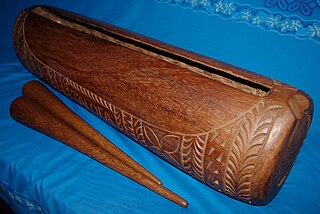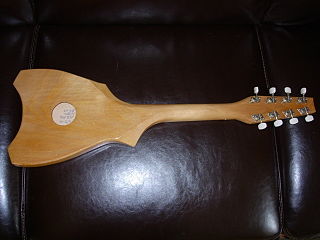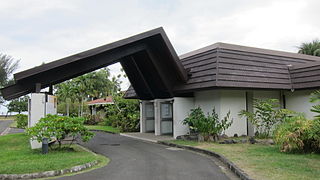
Tahiti is the largest island of the Windward group of the Society Islands in French Polynesia. It is located in the central part of the Pacific Ocean, with the nearest major landmass being Australia. Divided into two parts, Tahiti Nui and Tahiti Iti, the island was formed from volcanic activity; it is high and mountainous with surrounding coral reefs. Its population is 189,517 inhabitants, making it the most populous island of French Polynesia and accounting for 68.7% of its total population.
In Tahiti and adjacent islands, the term Maohi refers to the ancestors of the Polynesian peoples.
The music of Polynesia is a diverse set of musical traditions from islands within a large area of the central and southern Pacific Ocean, approximately a triangle with New Zealand, Hawaii and Easter Island forming its corners. Traditional Polynesian music is largely an inseparable part of a broader performance art form, incorporating dance and recital of oral traditions; most literature considers Polynesian music and dance together. Polynesian music expanded with colonial European contact and incorporated instruments and styles introduced through a process of acculturation that continues to the present day. Although the European tradition of hymn-singing brought by Christian missionaries was probably the most important influence, others are evident; Hawaii's influential kī hōʻalu music incorporated the Spanish guitar introduced in the late 19th century, and later introduced the steel guitar to country music. Hip hop and R&B influences have created a contemporary Urban Pasifika music genre with a strong Polynesian identity and supported by the annual Pacific Music Awards in New Zealand.
The music of the Cook Islands is diverse. Christian music is extremely popular. Imene tuki is a form of unaccompanied vocal music known for a uniquely Polynesian drop in pitch at the end of the phrases, as well as staccato rhythmic outbursts of nonsensical syllables (tuki). The word 'imene' is derived from the English word 'hymn'. Likewise the harmonies and tune characteristics / 'strophe patterns' of much of the music of Polynesia is western in style and derived originally from missionary influence via hymns and other church music. One unique quality of Polynesian music is the use of the sustained 6th chord in vocal music, though typically the 6th chord is not used in religious music. Traditional songs and hymns are referred to as imene metua.

Prior to the arrival of Europeans, the music of Tahiti was dominated by festivals called heiva. Dancing was a vital part of Tahitian life then, and dances were used to celebrate, pray and mark almost every occasion of life. Examples include the men's ʻōteʻa dance and the couple's 'upaʻupa.

The traditional music of Tuvalu consists of dances, including fatele, fakanau and fakaseasea. The influence of the Samoan missionaries sent to Tuvalu by the London Missionary Society from the 1860s resulted in the suppression of songs about the traditional religions or magic and many songs were lost. As the influence of the missionaries diminished in the 20th century the traditional dances were revived and the siva dance tradition from Samoa also became popular. The fatele, in its modern form, is performed at community events and to celebrate leaders and other prominent individuals.

The music of Tokelau occurs in the atolls of Atafu, Nukunonu, and Fakaofo. It is dominated by communal choral activity in harmony, with percussive accompaniment including log drums (pate), pokihi and apa. Nukunonu is notable for traditional song and dance.
The Polynesian Cultural Center (PCC) is a family-centered cultural tourist attraction and living museum located in Laie, on the northern shore of Oahu, Hawaii. The PCC is owned by The Church of Jesus Christ of Latter-day Saints, was dedicated on October 12, 1963, and occupies 42 acres of land belonging to nearby Brigham Young University–Hawaii (BYU-Hawaii).

Samoans or Samoan people are the indigenous Polynesian people of the Samoan Islands, an archipelago in Polynesia, who speak the Samoan language. The group's home islands are politically and geographically divided between the Independent State of Samoa and American Samoa, an unincorporated territory of the United States of America. Though divided by national border, the culture and language are the same.
Himene tarava is a style of traditional Tahitian music.

The Pātē is a Samoan percussion instrument of Tahitian origin, named after the Samoan word for "beat" or "clap" "pulse". It is one of many Samoan log drum variants and is of the slit drum family, and therefore is also of the idiophone percussion family. It is made from a hollowed-out log, usually of Miro wood and produces a distinctive and loud sound. Different sizes of log drums offer different pitches and volumes, as well as striking the log drum in the middle or near the ends.
Miss Tahiti is a long-standing beauty contest competition which awards prizes to young women contestants from Tahiti to Miss France as territory. It makes it possible to compete at some International pageants in order to represent the island as a territory.
Rae-rae are trans women in Tahitian culture, a contemporary distinction originating in the 1960s from Māhū, which is the more traditional social category of gender liminal people of Polynesia. Petea is a disparaging term for cis-male homosexuality used in French Polynesia, in contrast to traditional social category aikane used in Hawaii.
The ʻupaʻupa is a traditional dance from Tahiti. It was mentioned by European explorers, who described it as very indecent. It is not quite clear how similar the gestures at that time were with the now immensely popular tāmūrē. In both dances the performers form groups of pairs of a boy and a girl, dancing more or less in sexually oriented movements.

The tāmūrē, or tamouré as popularized in many 1960s recordings, is a dance from Tahiti and the Cook Islands and although denied by the local purists, for the rest of the world it is the most popular dance and the mark of Tahiti. Usually danced as a group of boys and girls, all dressed in more.
The ʻōteʻa is a traditional dance from Tahiti characterized by a rapid hip-shaking motion to percussion accompaniment. The dancers, standing in several rows, may be further choreographed to execute different figures while maintaining the hip-shaking. The hip motion itself may in some choreographies be synchronized amongst multiple dancers and may be further coordinated with the accompanying percussion arrangement.

The Tahitian ukulele is a short-necked fretted lute with eight nylon strings in four doubled courses, native to Tahiti and played in other regions of Polynesia. This variant of the older Hawaiian ukulele is noted by a higher and thinner sound and an open back, and is often strummed much faster.
Bobby Holcomb (1947–1991) was an artist and musician who wrote popular Polynesian tunes.

The Musée de Tahiti et des Îles, Tahitian Te Fare Manaha, is the national museum of French Polynesia, located in Puna'auia, Tahiti.

The Tahitians, are the Polynesian ethnic group indigenous to Tahiti and thirteen other Society Islands in French Polynesia. The numbers may also include the modern population in these islands of mixed Polynesian and French ancestry. Indigenous Tahitians are one of the largest Polynesian ethnic groups, behind the Māori, Samoans and Hawaiians.









